Member Engagement and the Changing Role of Associations [3/5]
Associations struggle with engaging members and connecting them to each other year-round, leading to a lack of perceived value in membership. How can you improve member engagement? The “Digital Service & Communication Model for Associations” provides insight into your association’s current standing and provides insight on how to facilitate engagement and connection more effectively. Mathijs and Dennis explain this and offer numerous tips for fostering a thriving digital association.
By: Mathijs Vleeming & Dennis van Aalst, Yard | Digital Agency
Also read:
- Part 1 on the “Digital Service & Communication Model for Associations”.
- Part 2 on the “Value of knowledge sharing within an association”.
(click on image to enlarge)
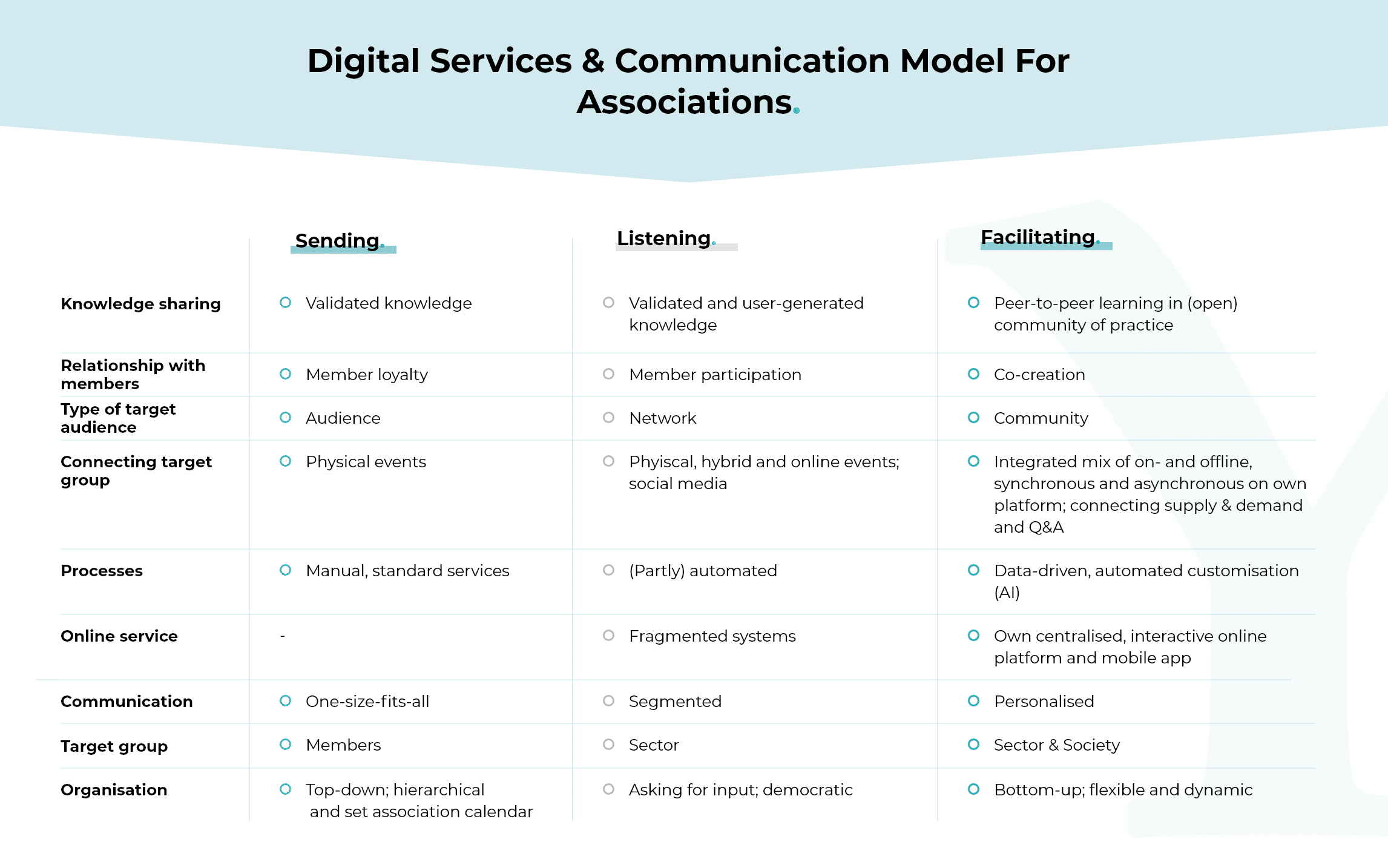
Connecting as a Core Task
A core tasks of an association is to connect its members. You could even argue that connecting members is the primary function and the very reason for the association’s existence.
The way associations connect their members is evolving.
Traditional Connection: Physical Events

Broadcasting or sending associations typically connect their members only a few days a year, through physical events such as conferences. For the rest of the year, they provide little to no ongoing interaction between members, mainly communicating one-way from the association to the members, often via email. This lack of continuous engagement leads to a dilution of member involvement.
In this traditional “Connection 1.0” model, the association facilitates knowledge and connection only for those who are physically present at the event. If you are not in attendance, you cannot fully benefit from your membership, missing out on access to the knowledge and connections with other members. This exchange of knowledge and connection is a major value proposition of industry and professional associations.
The Listening Association: Offline and Online Events

The listening association takes things a step further by utilizing digital possibilities and adopting a hybrid model of offline and online events (“Connection 2.0”). This model allows the association to facilitate connections between members through multiple physical and virtual events. However, outside these events, members do not have ongoing interaction with each other. If members do not attend an event, they miss out on access to other members and the knowledge shared during these gatherings. As a result, only those who participate directly experience the full value of the association.
While the listening association does facilitate connections and knowledge sharing among members, it still does so to a limited extent. Most events primarily focus on sharing validated knowledge, with less emphasis on the collective wisdom of the crowd. However, the use of bottom-up approaches is increasing, with formats such as unconferences and working groups being incorporated into events to encourage more participatory knowledge sharing.
Challenges with Physical and Online Events
Such physical and virtual events face two major challenges:
- Creating Sustainable Connections
- Continuing Interaction and Knowledge Sharing
This occurs because interaction and connection between members are abruptly off after the event (“See you next time!”). Consequently, member engagement also ends abruptly, which can reduce long-term involvement and commitment to the association.
The Facilitating Association: Smart Mix of Offline and Online
Facilitating associations address this challenge by leveraging online capabilities to maintain member connections throughout the entire year (“Connection 3.0”). This approach creates a more consistent engagement pattern, avoiding the abrupt peaks and valleys of traditional event-based interaction. Online platforms enable continuous connection, making engagement possible anytime and anywhere. Events then serve as highlights in the ongoing cycle of member connection and involvement, continuing year-round, 365 days a year.
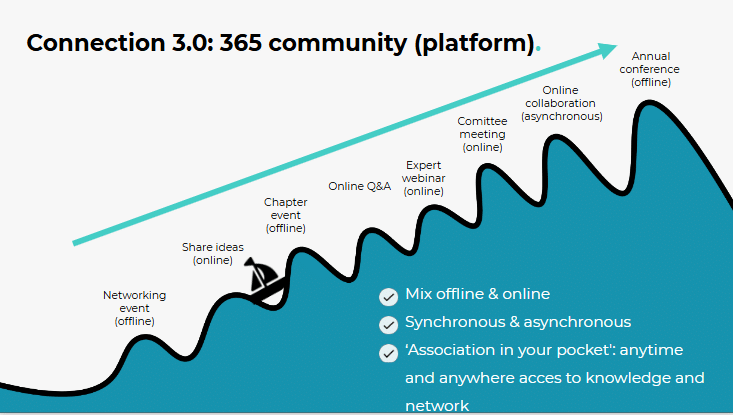
Mixing the power of online and offline
If you combine offline and online, you are also combining synchronous and asynchronous communication. Both have advantages and disadvantages. Offline communication is synchronous. As a result, it is intimate, deeper conversations are possible and unexpected insights can arise more easily. But it is also transient and less accessible. Asynchronous online communication is available anytime, anywhere. It is also permanently stored and retrievable. As a result, its reach is greater.
In a smart digital communication and service strategy, the different forms of online and offline, and synchronous and asynchronous communication reinforce each other. Events reinforce online activity, and online activity creates higher-quality events, where more members participate. The art and challenge for associations looking to engage more members lies in finding this mix of best of both worlds.
Changing way of communicating
Why a mix of online and offline works best also has to do with the changing way of communicating within different types of associations. Sending associations treat members as an audience. They send information to their members; it is one-way traffic. The listening association sees members as a network. In a network, you only have access to everyone connected to you. It is, after all, your network. Often there is only one-on-one interaction.
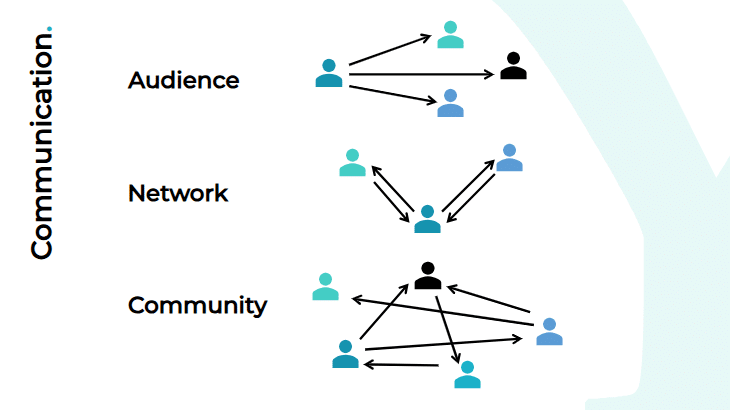
The facilitating association treats members as a community. These associations connect their members directly to each other based on common denominators, like interest, expertise, location, level of experience or a specific topic. They amplify the “sense of membership/community” and pro-actively facilitate and enhance relationships and collaboration between members (hence the thicker arrows in the above image). By making them feel heard in a trusted environment with like-minded peers they take more ownership of their membership and increase their contribution. To work together toward a higher goal. That goal is the mission of the association. A facilitating association often also involves their wider sector.

Relationship with members
If the role of your association changes from sending, through listening to facilitating, then the relationship with your members also changes structurally. The sending association does member retention. But communication is top-down and members have little say or input. The listening association occasionally consults what members want, for example through surveys and research. In this way, members have a limited say in the association’s services and advocacy.

The enabling of facilitating association engages in co-creation with its members and external stakeholders. The association proactively challenges members and other stakeholders to work together. The association also facilitates members to use each other’s knowledge and not do everything themselves. This requires a distinctly different relationship of the association with members. You can read more about that in the fifth and final blog in this series.
If you want to build an audience you help people. If you want to build a community you help people help each other
David Spinks
Facilitating co-creating
Co-creation can be smartly facilitated online with a community platform. The key question here is: how can my members help each other? Do you have a clear answer to this question and do you proactively stimulate member interaction and co-creation? Then you create added value with an online community platform and increase your impact as an association.
Case: Taking the procurement profession to the next level together
Nevi’s Inside Procurement is the knowledge network for procurement, contract and supply management. Professionals and experts share knowledge, expertise, experiences and other valuable information in this community. Read more in the customer case about Nevi.
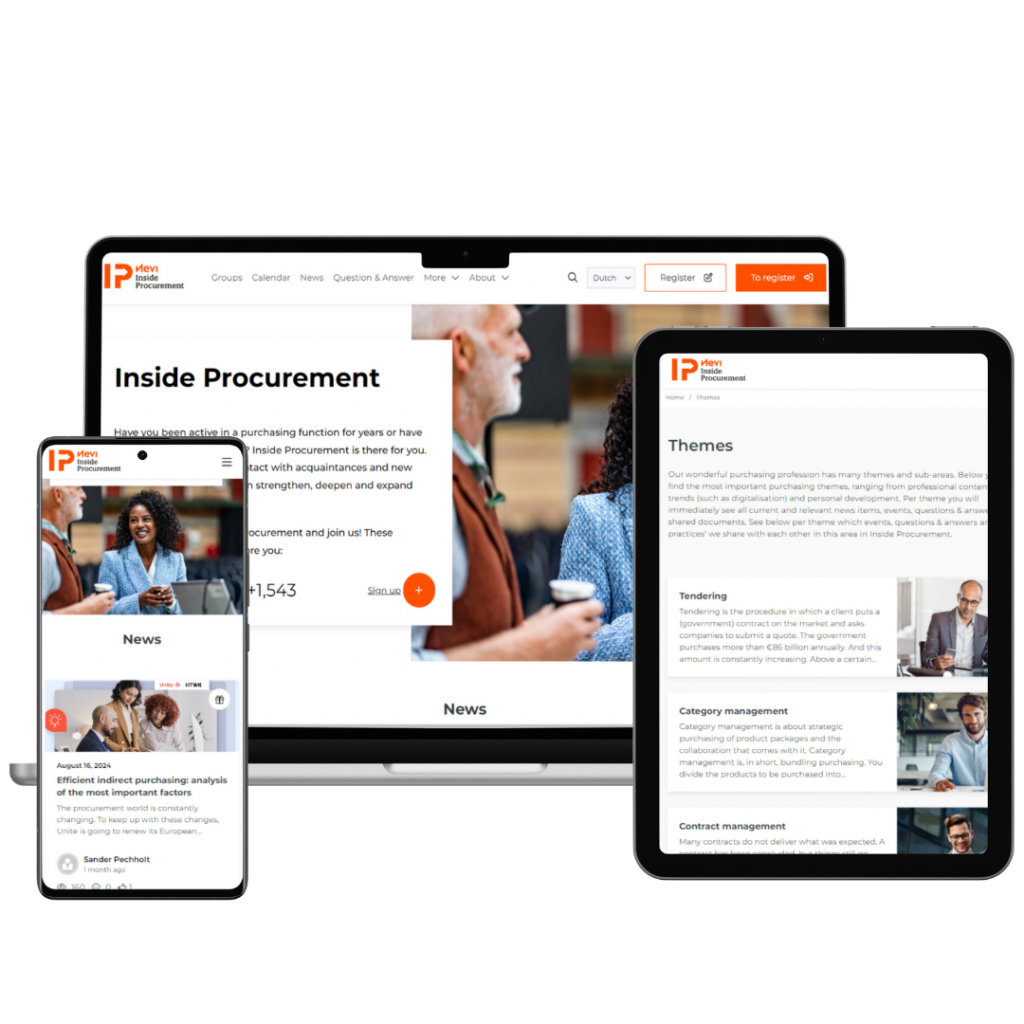
Case: How does cooperative Horticoop do it?
An odd one out is cooperative Horticoop. Yet this is a great example of how to make use of member knowledge. In fact, this cooperative has a lot of association characteristics. Horticoop collectively invests in supplying companies. And their members are trying to make better investment decisions through their online platform. Cooperation is in the DNA of this cooperative.
Through an online platform, members are in constant contact with each other. This allows them to respond quickly to trends and identify opportunities. So that together they start or purchase the right businesses. Through their online platform and digital communication and interaction, they are better able to achieve their goals.
Next time: digital services and the changing role of associations
Successful associations facilitate knowledge sharing and connection among members. All year round. But how do modern associations do this specifically?
About the Authors
Mathijs believes that associations can increase their impact by connecting their members throughout the year and facilitating knowledge sharing. He draws on his 20 years of experience in the “heart of the world of professional community builders,” specifically in the international meetings industry for association conferences and events at the International Congress and Convention Association, where he was Director of Marketing.
For over 3 years, Mathijs has worked as a community strategist and consultant. In this role, he helps associations and other organizations create online community strategies. He does this at Yard Digital Agency, the market leader in digital communication and community solutions for associations and public organizations in the Netherlands.
Mathijs wrote an eBook with input from associations and community leaders titled “The Association Community Compendium: How to Harness the Collective Power of Your Members.” He is also a board member of the Community Consultants Collective and a contributing expert for Association Meetings International.


Dennis believes in the power of digital. With passion, he and his motivated colleagues support social organizations in achieving digital impact. Dennis is an experienced online strategist within the association sector. [Can you provide evidence of this and share more about your experience with associations?] Due to his in-depth knowledge of associations, he serves as a sparring partner and advisor for associations looking to grow digitally.
Together with the KNVB and Yard | Digital Agency, Dennis won the Dutch Interactive Award (DIA) 2021 in the category of communities. They won this award for the platform Eén tweetje, for which Dennis developed the strategy in collaboration with the KNVB [is this correct?]. “The community represents a game changer in the way the KNVB communicates,” according to the jury. “A shift from top-down to peer-to-peer.”
Additionally, Dennis is a trainer in digital communities at De Nederlandse Associatie (DNA). Through open and in-company workshops, he helps industry and professional associations discover the value of an online community. He also guides them in launching an online community and fostering interaction and engagement within the community.

Watch: Case Study TVVL
TVVL is the largest association of professionals in installation technology. How does this association use digital possibilities to connect its members and exchange knowledge? John Lens, Director of TVVL, talks about it with Mathijs Vleeming and Dennis van Aalst.
Also read
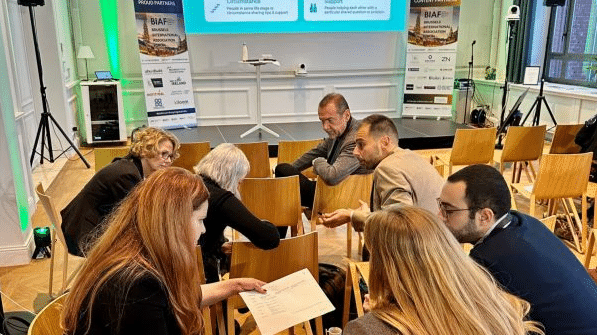
Digital services and the changing role of associations [4/5]

Community building is the core business of associations

